Want a more visual way to maintain your timeline?
Events vs. tasks – a time thing
There are many overlapping areas when it comes to defining what a task is and what an event is. It gets a little fuzzy when you start to ponder. One might come up with some general definition… but there are so many exceptions to any possible definition. So we're not going to try and make a clear distinction. The only helpful distinction for the purposes of the timeline is a practical one: relationship to time.
1. Generally, an item that is bound to a specific block of time, I'd say is an event. Events are part of a structured routine and/ or involve a commitment. To move or cancel an event, you'd need a good reason. For instance: a coaching session, a team meeting, dropping off and picking up kids from school and sports practice.
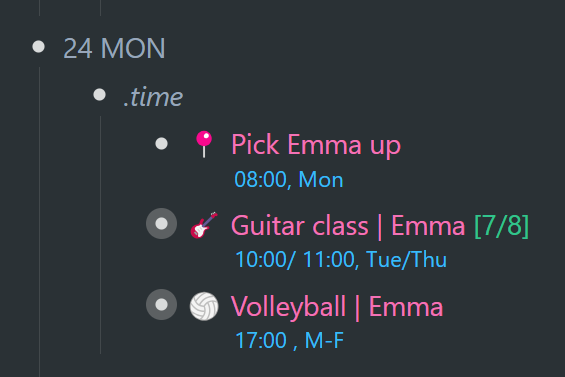
2. Anything else that is not bound to a specific block of time could be seen as a task (or a series of tasks). Of course, there are exceptions… but broadly speaking, it is very helpful and practical to identify and group items organizationally, according to those items that are bound to time blocks and those that are not.
Now as to tasks, we can distinguish between 2 general categories:
(A) Tasks that are bound to a day (but not necessarily to a specific time slot)
The time is flexible. As long as it gets done on or by a specific day. Most notably, bills to pay:
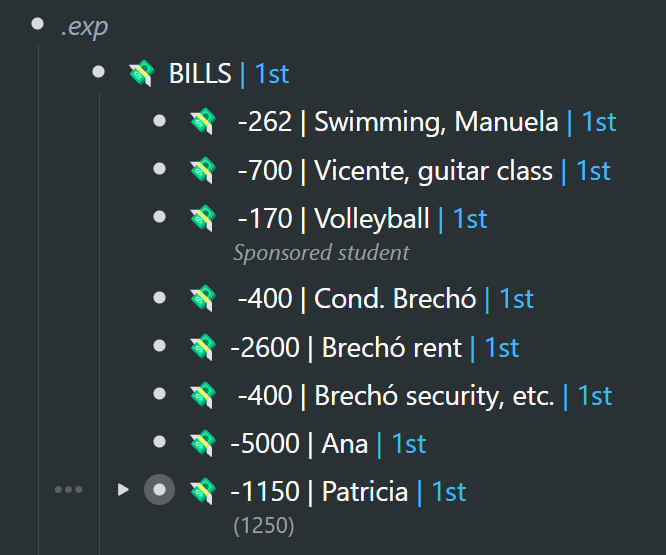
Below you'll see a reminder for my nephew's birthday, as well as items I like to act on at the end of the month (EOM), one being a few digital backups. There is no fixed time for what needs to be done. My nephew lives in New Zealand and I in Brazil. So it's not an event for me. Not this year.
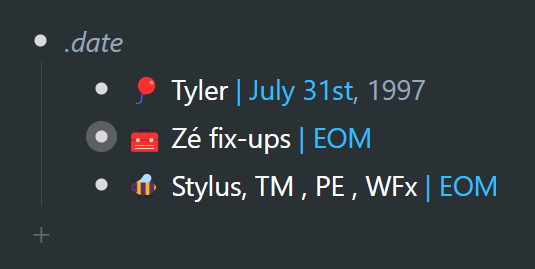
In the above two screenshots, I've simply included the date or the day of the month in the task/ reminder title. You can style the dates however you want… but the main reason I don't include the metadata in a note (for items that don't have a specific time), is that I want these items to be visually different to items that are events that occur at specific times. It is worth taking a few seconds to sculpt events and tasks to look the way you want them to look. Many of these are going to live on your timeline for months to years. The vast majority of the date-related tasks are going to repeat on your timeline, again and again.
(B) There will also be a category of tasks that are once-off items, or are infrequent enough to not have to be done on a specific day
I clip my cockatiels' wings every 2 months, and so it doesn't have to be on a specific future date. I have the flexibility to push it ahead a week or two if I choose. And setting up a Wi-Fi booster is a 10-minute affair, max. I just need to take the thing out of the box and tinker and test.
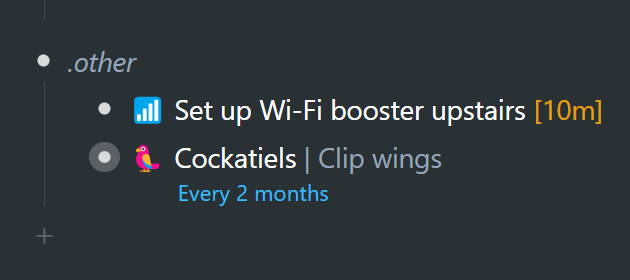
± Four categories
In my tickler file/ calendar, I find it helpful to categorize according to these 4 general categories within each date (you can create your own):
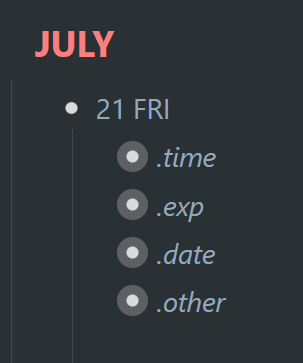
There are a few great reasons why you might want to have some basic categories within each day slot in your calendar/ tickler file. We're going to pick up on this a little further along »… but for now, the one I'd like to mention is this: ease of admin/ planning for your next day…
1. Time sensitive
At the end of the day, when I schedule for tomorrow, the items in my .time category are events that I can quickly drag and drop into the corresponding time slots in my left bar. These events create context and structure in my day (along with other daily routines)… and every other task will fill in around the fixed landscape items. I don't need to guess where these items slot into… it says it on the outside of the can:
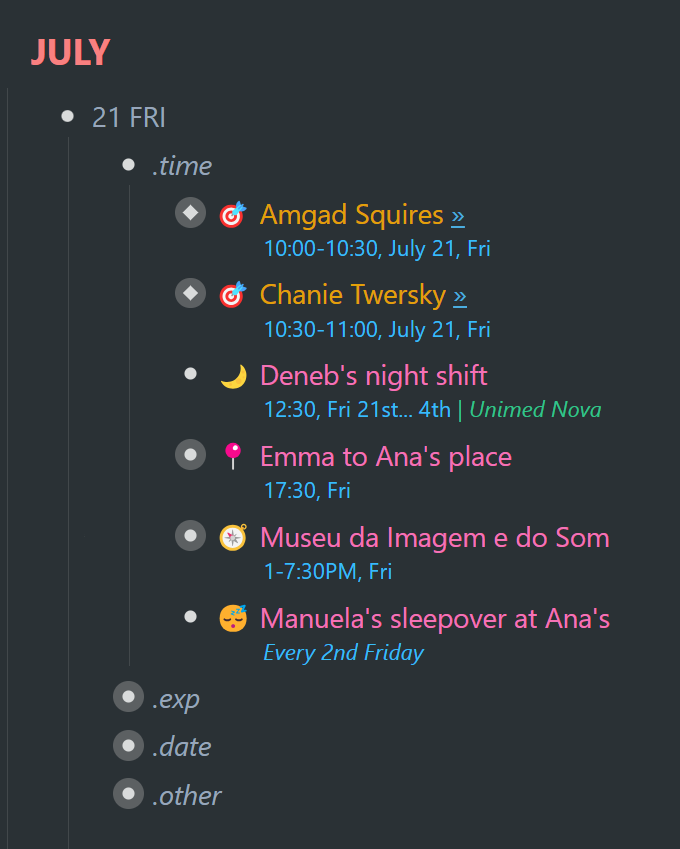
I've got a couple of coaching sessions in the morning (yellow) and several other activities and responsibilities with my girls (pink). These items are fixed. I'll need a good reason to cancel or move any of these. They don't just get brushed aside. They give me something solid to build around. The other three categories below fill in around these fixed events and plans…
2. Expenses/ finances
Like everybody else, I've got monthly recurring expenses and a budgeting workflow. We'll look at some fantastic strategies for keeping on top of your finances by utilizing the timeline in a later chapter ». I have a significant number of budget-related items – and while these items could easily go under the ".date" category, I think they deserve their own dedicated category. We'll get to this in due course.
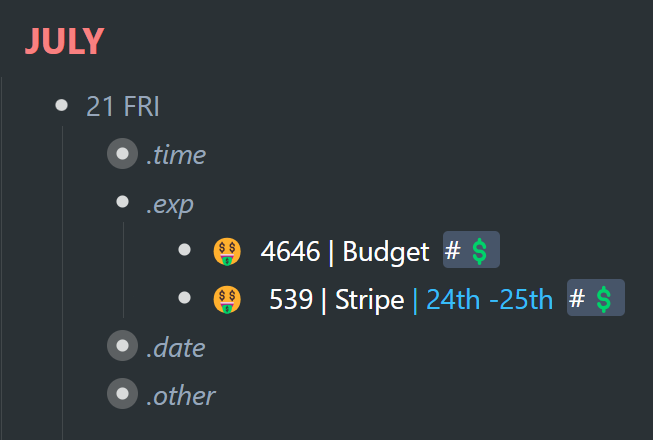
3. Date specific
These are the date-related (but not time-specific items), which are flexible enough to fit in around the hard landscape of my daily-planner time blocks.
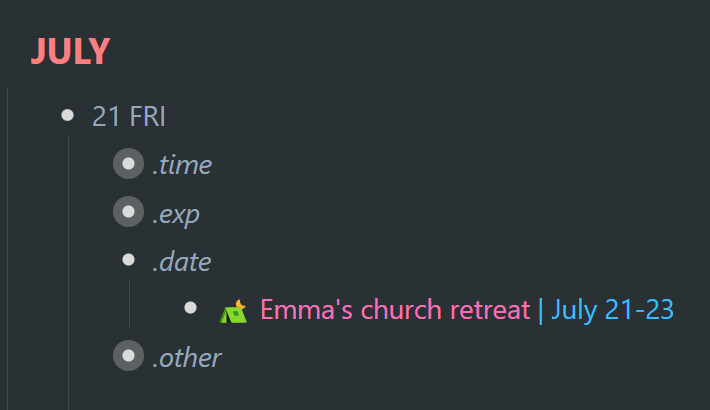
There's not much to show and tell in this category for tomorrow. It's the start of a 3-day event for my elder daughter.
4. Other
I have all the items that are neither day nor time specific grouped together. These items may or may not repeat on my timeline – however, they have been purposefully slotted into this calendar day so that I can either consider, be reminded of or act upon them. They appear here because I made a micro decision at some prior point to push them to the next logical, reasonable or opportune time on my timeline. And that happens to be tomorrow. I may decide that one or more of these items needs to get pushed to another date on my timeline… or I may engage. I'll explain the mobile inbox outline in an upcoming chapter ».
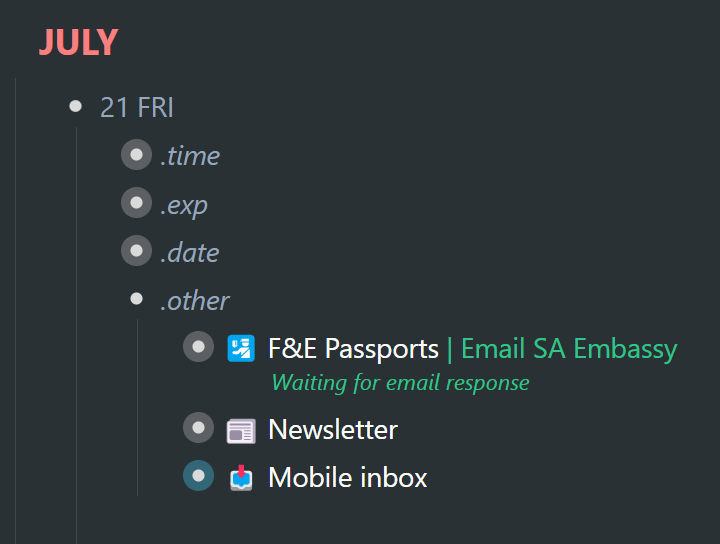
Perspective
These categories help me to act and think strategically about all of my life's activities. One gets the sense that there is rhyme and reason to the events and tasks we've chosen to bring into our timeline. We also get to easily see what our upcoming workload consists of… we can see if there is too much on our plates and adjust if necessary. We are able to push certain items to a later date if need be – and this tends to mainly happen with the items in my ".other" category. On occasion, depending on life's demands, I may just conveniently push the ".other" category to the next day or the next best place along my timeline. And so there is a general progression—top to the bottom—from fixed events that are strong, established commitments, to the more flexible (and sometimes) optional items.
One also gets to see that life's activities are not infinite… they are rather finite and very manageable. It's easier to see this when you group like items according to some kind of logic.
These four categories are not essential. They're just an additional aid on my timeline. They help with movement. They're not permanent homes for specific items… they're simply contexts. You can create whatever contexts you'd like under each date in your calendar – as well as contexts across your entire timeline. More to follow! All of this to say that you should not lose sight of the core timeline dynamics presented in this book. Any additional categories you create are to serve you… not for you to serve them. Whatever helps streamline the timeline, use that. Discard anything that becomes a hassle or creates extra admin. Get it down to the essential.
Checklists →Workflowy is a minimalist note taking app that helps you organize your life. Simple enough to hold your grocery list, powerful enough to hold your entire life.